Of Emus and Fairy-wrens
Photographing Australia’s Endemic Birds
Monthly Newsletter
August 2006
It is August 21, 2006, and I am sitting in a comfy camp chair next to a roaring fire keeping myself warm while I write my first newsletter for this project. It is quite an idyllic setting with an amazing display of stars unlike anything I have ever seen. The Milky Way seems to light up the sky while the millions of stars form constellations unknown to me on this side of the equator. It has been about three and a half weeks since I have left the States and I can hardly believe it. Time has really flown by and been full of surprises, both good and bad.
I feel like I finally have my feet under me. Driving on the other side of the road is becoming natural and I haven’t tried to get in the left side of the car in a while. I am starting to learn the birds, yet nearly everyday I see at least one new species. While I haven’t seen many, the mammals here bounce, not run which takes me by surprise every time. The people are as friendly as their reputation and every single person has gone out of their way to make my time here wonderful.
Just a couple days ago, I set out in my newly purchased vehicle and left the city of Sydney behind. For the last three weeks, I have been spending my time split between the city and the local countryside. While in the city, I worked to prepare myself for the upcoming year’s journey and then I would escape to explore the surrounding areas. To some extent, big cities are big cities, though I should say that Sydney is quite a neat city. Where else can you stumble upon Sydney Harbour with its colossal bridge and magnificent opera house? Furthermore, it is a clean city that felt extremely safe the whole time I was there and I spent a large amount of time walking the streets. That being said, my passion and my project are focused on birds. So, as often as I could I escaped to the surrounding national parks and other areas.
I spent five days in The Royal National Park, less than an hour south of the city. This is the world’s second oldest national park, only younger than Yellowstone National Park in the States. It is quite a diverse park ranging from rainforests in the lowlands and along the rivers to dense heathland at higher elevations. Beautiful sandy beaches and steep rocky cliffs line the coast. It really is a spectacular place and home to numerous plants and animals. While I was there, many of the plants were beginning to bloom, but for the most part I was a bit early as it isn’t quite spring yet. In fact, my third morning in the park had me scraping ice off my windscreen (windshield) before I could drive off to photograph. However, I have enjoyed pretty much all of it, even my first night camping when in I had to go outside in the pouring down rain and gusty wind to restake my tent since the wind had blown the stakes out.
I have been fortunate to have received the hospitality of a number of local photographers who have been more than willing to share their local knowledge with me. One even invited me to tag along on a business trip, which actually was three and a half days of birding plus a couple hours of meetings one day. It just so happened, that the location of the meeting was 600 km west of Sydney, near a great birding spot. It was a great few days but we had to work hard to find the birds we did see. Even so, most of the birds were new for me and seeing the interior regions of New South Wales was fantastic.
As I sit here and write this newsletter, I feel like I am finally on my way. There have been some bumps, but for the most part everything has gone smoothly. In just over three weeks, much of which was in the center of Sydney, I have managed to see over 160 species of birds and photographed over 70 of those species. My target species, those 300+ endemics, are coming along nicely. If I set a goal of one new endemic species photographed everyday, then well there aren’t enough species to last the year. However, I feel like if I aim for that as a goal, I might just end up photographing quite a few of them. Well, today is my 25th day in Australia and so far I have photographed 33 species. Granted most of those are common birds, but it’s a good start especially considering the amount of time I have spent in the city.
Over the next twelve months, actually a little bit less, I will be on the road exploring this magnificent country. I hope that these newsletters will help you to follow my travels. I plan to send each newsletter sometime in the middle of each month depending when I am at a computer and able to send it. If you are interested in more than just a monthly update, then follow the weblog on my website. There I post a daily image with a bit of what I did that day. Also, as I begin to experience more places, I will be posting photo essays in the travel log section as well. The first should be posted by the time you read this newsletter. The photo galleries are also full of photos and I will be adding to those whenever I can, but they require a significant chunk of time to do while connected to the Internet, a convenience I don’t often have.
Also, feel free to email me anytime but be aware it may be up to a couple weeks before I can respond. My goal is to reply to every email when I receive it, but I simply don’t get connected to the Internet except every few weeks. Be patient, I promise I will respond. Thanks for your support and I hope you enjoy following along with me on this journey.
Photos
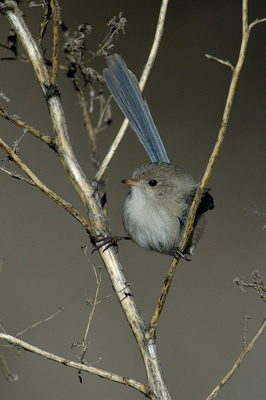
White-winged Fairy-wren – Lake Cargelligo Sewage Works, New South Wales
Well, I figured the first image of my newsletter should be a Fairy-wren since it is the title of my project. This is a female White-winged Fairy-wren and while I love this image, the male White-winged Fairy-wren will about blow you away. Its entire body is bright iridescent blue with brilliant white wings. The family group that I was photographing had a very skittish male but the females were a bit more cooperative.
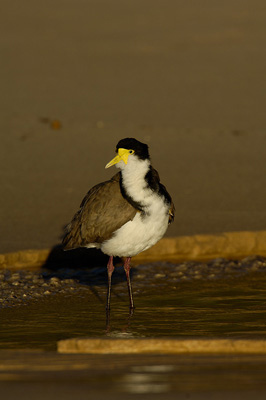
Masked Lapwing – Garrie Beach, Royal National Park, New South Wales
This was the very first bird that I photographed and one of the first species I saw after arriving in Sydney. The Masked Lapwing is a type of plover, similar to a sandpiper. This particular species used to be called the Spur-winged Plover as they have a small, yellow bony spur that sticks out of their wing.
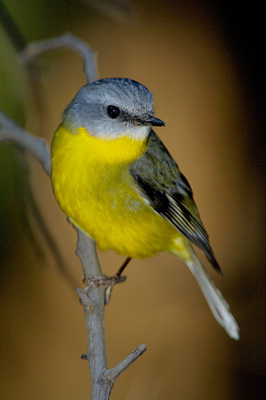
Eastern Yellow Robin – Wattle Forest, Royal National Park, New South Wales
This Eastern Yellow Robin is a small and rather cute little bird. This image is one of my favorites and was one of the first images I captured on my own with which I was really pleased. The Australian Robins are much different from the North American robins, members of the thrush family. In Australia there are about a dozen different species and my guess is that they reminded Europeans of the European Robin and that is how they were named.
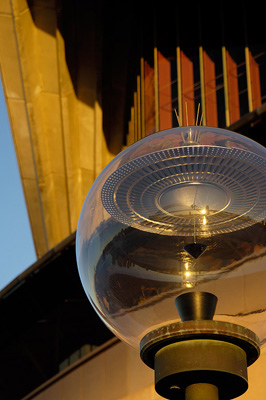
Opera House and Harbour Bridge – Sydney, New South Wales
Since I have spent so much time in Sydney, I figured I needed to post at least one image of iconic Sydney. This is surprisingly one of my favorite images from the trip so far and has nothing to do with a bird. After spending the first few evenings of my trip at the harbour for sunset, I decided I needed to at least take a few photographs. However, I didn’t want to just take the standard shots of the bridge and the opera house. I wanted something different, something original. One evening I saw this scene and knew I had to return the next night to actually photograph it. It is difficult to tell at this size, but the background is the opera house and the foreground is a street light. In the streetlight, the harbour bridge and sunset is reflected. Again, a large print would make this a bit more obvious and is what I plan to do as soon as I can.
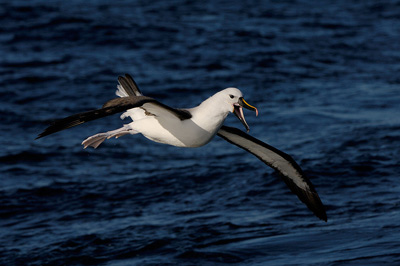
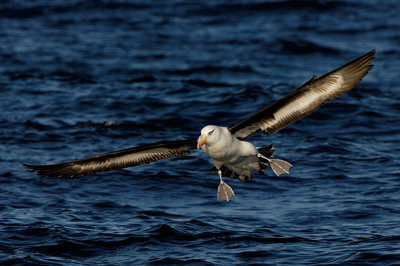
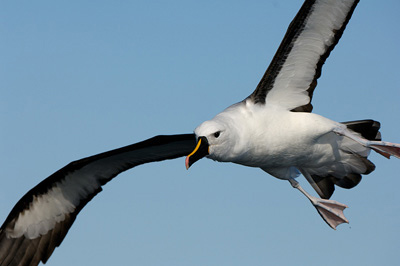 Yellow-nosed and Black-browed Albatrosses – Offshore Wollongong, New South Wales
Yellow-nosed and Black-browed Albatrosses – Offshore Wollongong, New South Wales
I spent an entire day at sea photographing pelagic birds like these albatrosses. Considering I had never even seen an albatross before in my life, it was quite a magical day. I was able to photograph at least five species and even hold a Wandering Albatross in my lap while it was banded. Photographing flying birds in a rocking boat at sea is quite a challenge but I was thrilled with the images when I returned. The top and bottom images are of Yellow-nosed Albatrosses and the middle image is of a Black-browed Albatross.
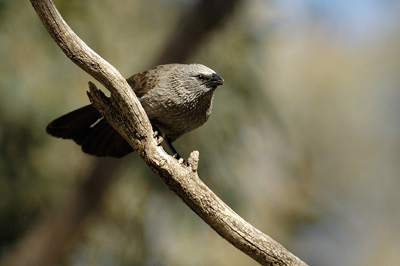
Apostlebird – Lake Cargelligo, New South Wales
During my third week here, I accompanied another birder and photographer into western New South Wales for a business trip that was surrounded by several days of birding and photographing. Photographically it wasn’t a spectacular trip as opportunities were limited, but I was able to see many species found in the Australian bush like this Apostlebird.
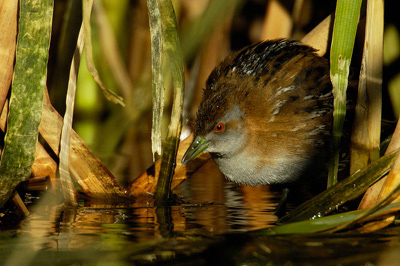
Baillon’s Crake – Lake Cargelligo Sewage Works, Lake Cargelligo, New South Wales
Probably one of my favorite bird families, Rallidae, is also one of the most difficult to see, much less photograph. This family includes the rails, gallinules, and coots. The rails especially are typically very secretive birds hiding in dense marshes and only venturing out to the edges at dusk and dawn. This image is by far my best image of any rail or crake and while Baillon’s Crake is not an endemic, it is one of my favorite images.
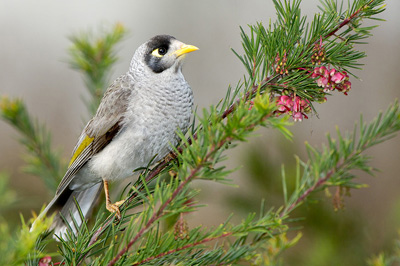
Noisy Miner – Centennial Park, Sydney, New South Wales
I thought I would end with two fairly common birds that are both beautiful birds and representatives of two large families found in Australia. This Noisy Miner is a member of the Honeyeater Family (Meliphagidae), a huge family found only in Australia and New Guinea and surrounding islands. Australia has over 70 species of Honeyeaters and most of them are considered endemics. As their name suggests, these birds feed on nectar in flowers making them a challenge to photograph since the birds are often small and in the canopy of Australia’s many flowering trees.
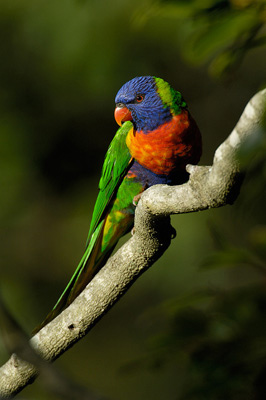
Rainbow Lorikeet – Bonnie Vale, Royal National Park, New South Wales
Australia also has a wide variety of parrots and cockatoos. This Rainbow Lorikeet is an extremely common bird in cities and their loud screeches can be heard as they fly around. I was surprised to find that many of Australia’s parrots are actually ground feeders, feeding on seeds and grain. Also, rather surprisingly, they are found in basically all habitats from the tropical rainforests of the north to the central deserts. In fact, I hope to go on an expedition in July into the central deserts in order to search for the Princess Parrot, more to come on that later.
